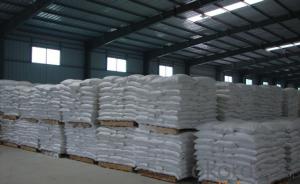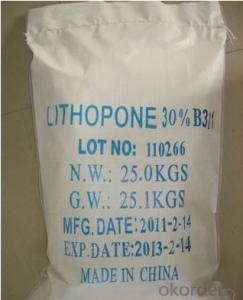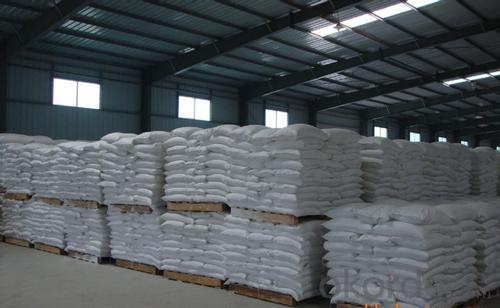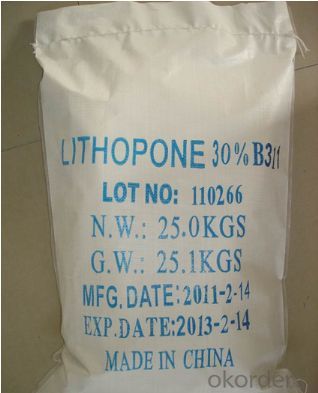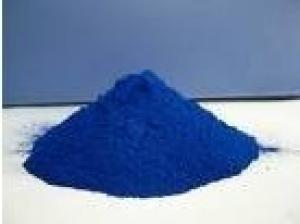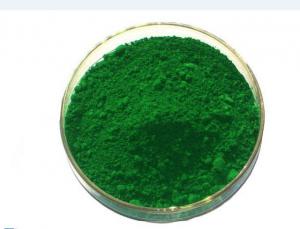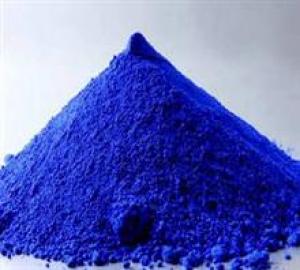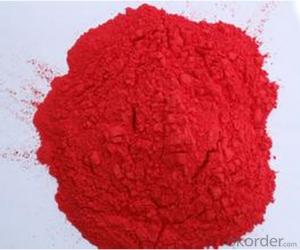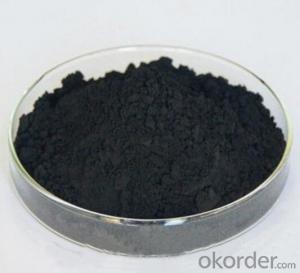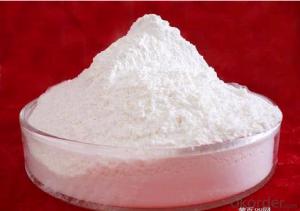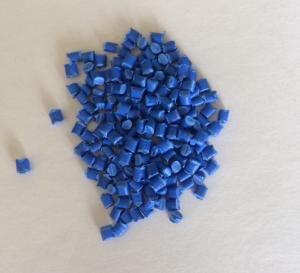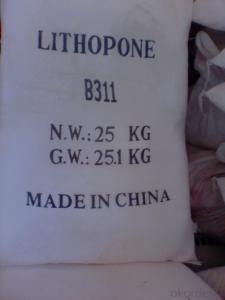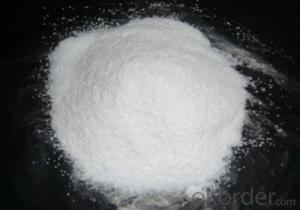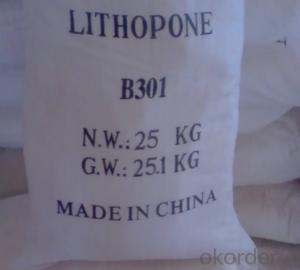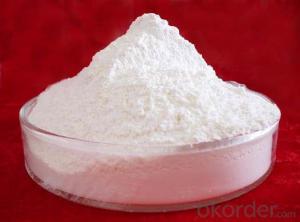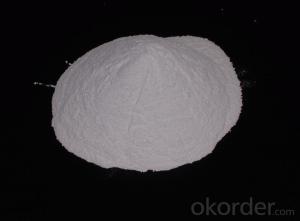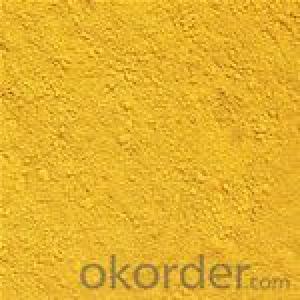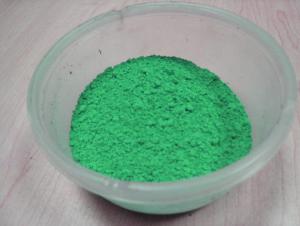White Powder Pigment Lithopone 28%-30% For Paint &Coating
- Loading Port:
- Tianjin
- Payment Terms:
- TT OR LC
- Min Order Qty:
- 20 m.t.
- Supply Capability:
- 2000 m.t./month
OKorder Service Pledge
OKorder Financial Service
You Might Also Like
Specifications of Lithopone
1.The factory direct sell
2.Free samples
3.Visit our booth for more details
Lithopone(B301 B311)
1.well-used in paint-making, printing ink, plastics, leather, PVC
2.lithopone 28-30% b311 b301
3.high quality
4.low price
Features:
1) A white pigment produced by precipitation through filtering,
heating and quenching works
2) Has mostly been replaced by titanium dioxide which is more
durable, but it is much cheaper
Applications:
1) Used as a base for lake pigment
2) Used as a inert pigment for paint, ink and cosmetics
3) A large range of applications in plastic industry
4) Used as a filler in paper, leather, and linoleum
English Name: Lithopone(B301 B311) | ||
Item | Index | |
B301 | B311 | |
In terms of total zinc sulfide and barium sulfate the sum of% (m / m) ≥ | 99 | 99 |
The total amount of zinc (in zinc sulfide)% m / m) ≥ | 28 | 30 |
Zinc Oxide% (m / m) | 0.6 | 0.3 |
105 °C Volatile% (m / m) ≤ | 0.3 | 0.3 |
Water soluble% (m / m) ≤ | 0.4 | 0.3 |
Filter material (63μm filter)% (m / m) ≤ | 0.1 | 0.1 |
Color (with standard sample) | Excellent | Excellent |
Death by degrees to take liquid water | Neutral | Neutral |
Oil Absorption g/100g | 14 | 10 |
Reducing power (with standard sample)% ≥ | 105 | 105 |
Opacity (contrast ratio) | Not lower than 5%standerd sample | Not lower than 5%standerd sample |
Properties: This product is a kind of new-style nontoxic. Green non-pollution, lithopone than traditional lithopone albedo high, hiding power, fineness and high-temperature weatherability, strong characteristic. | ||
Uses: Widely used in coating, powder, plastic, profiles, paint, rubber, paper, and leather, etc. | ||
Packing: 25 kg/50kg P.P woven bag or with the clients’ request | ||
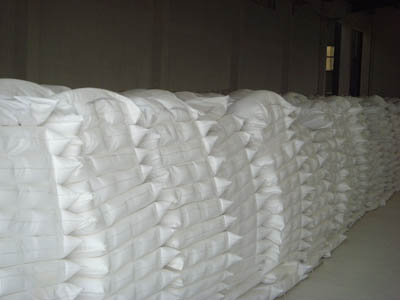
- Q: Can some one suggest chemical pigments that can be easily made from chemicals available in a chemistry lab for a project?I need the name of the pigment, reactants required and chemical equations of reactions involved.I need atleast 5 pigments
- Some pigments easy to make in a school laboratory: 1) Calcium carbonate: Mix solutions of calcium chloride and sodium carbonate : CaCl2(aq) + Na2CO3(aq) → CaCO3(s) + 2NaCl(aq) filter off and dry the calcium carbonate 2) Barium carbonate Exactly as above , but start with barium chloride 3) Calcium sulphate Mix solutions of calcium chloride and sodium sulphate: CaCl2(aq) + Na2SO4(aq) → CaSO4(s) + 2NaCl 4) Barium sulphate Use barium chloride instead of calcium chloride . 5) Satin white is another interesting pigment: Mix solutions of aluminium sulphate and calcium hydroxide with strong stirring , You get a paste which is a mixture of aluminium hydroxide and calcium sulphate . There is no specific formula because what you get depends on how you mix. Do not try and dry this out to get a dry pigment - it does not work. There are 5 white pigments that you can easily make - but remember to wear proper protective clothing when working with all chemicals
- Q: like what's the definition relating to sunlight
- Pigments are substances which are used familiarly to create pictures and printings. Pigments give an object a color when in a field of incident white light. Pigments themselves absorb a set of incident colors of light and reflect all others. When multiple pigments are mixed, their ability to absorb colors is added, such that their ability to reflect colors is subtracted.
- Q: okay so I have always used all the cheap makeup and I am sick of it! I was wondering if mac pigments will give me a lot of color without having to use half of the container. Most eyeshadows look nothing like they are supposed to on me. they are like 100 times lighter. I have seen beautiful things done with the pigments but they look like they could get everywhere really easy. will they give me vibrant color without getting all over?
- You okorder Goodluck!
- Q: what is the relationship between chlorophyll a, accessory pigment?
- Sativa- uplifting, high, trippy, baked out of your gourd, ****** up, spacy Indica- passing out, baked, stoned, sleepy, couchlock, retarded, weird dreams
- Q: I know the difference between the two, but which do you prefer? Which has a better color payoff? And, which do you own more of?
- Pigments they have a better color pay off ?
- Q: whats it for? lol
- itz for ur beautifing ur skin.
- Q: what are the differences between colorfast and non colorfast pigments?
- Pigments, are generally solids and are usually insoluble in the medium in which the pigment is being used. Pigments, are typically used instead of dyes in applications where color migration or bleeding is undesirable. One possible approach to create a colorfast pigment for use in something like toothpaste would be in a layered anion exchange material which is contacted with the dye under conditions in which a water-insoluble pigment is obtained. The water soluble dye and the layered anion exchange material would normally be contacted together in a liquid medium in which the dye has been dissolved. The layered anion exchange material is preferably a layered aluminate of some kind. Generally, pigments are graded by international standards for color fastness. Eight is the most color fast, and anything over six will do quite well out-of-doors. As ancient Frescoes, sand paintings, petroglyphs and other pure-pigment art demonstrate, certain pigments can remain in direct sunlight for thousands of years without any indication of fading. These pigments are earth, metal, and chemical colors that are neither dyes nor tints. Dyes and tints, such as alizarin crimson, berry juice, etc. will bleach quickly due to ultraviolet exposure that occurs in direct or indirect sunlight. Today most paints are derived from much different sources than they were as recently as fifty years ago. Real cadmium, cobalt, copper oxide, to name a few, are no longer used. They are now formulated to appear similar to the traditional pigments. They may be extended out with white, resulting in an appearance that can differ with traditional counterparts. For the most part these new colors are very colorfast and without the addition of medium or varnish they will not fade when left in direct sunlight.
- Q: I have been looking over the internet and have yet to find the details I need. Such as the function and development of Pigments.
- The most important characteristics of pigments are: 1. They impart a colour to the medium to which they are applied. Remember that you can get white pigments, titanium dioxide, and black pigments, carbon black is typical. The pigments impart a colour merely by their presence , they are mostly chemically inert.They need some binder to fix them to the substrate. 3.They are insoluble in the carrier in which they are processed. 4. Pigments can be inorganic or organic, but the majority have a metal in their structure. 5. Pigments can occur naturally, but synthetically produced pigments to precise standards are by far the most used in industry. 4. In contrast to this, colourants that dissolve in the medium in which they are processed are called dyes or dyestuffs. 5.Dyes are by and large purely organic in structure, and do not contain metals in their chemical formulation. 6. Dyes undergo a chemical reaction with the substrate which they colour. 7. There is also a third type of product called an extender or filler. In the surface coating industry clays, calcium carbonate, etc fill this role. They do not add any colour to the paint, they become transparent in the paint binder medium, because of their low refractive index. They add body to the paint.
- Q: How are plant pigments involved in photosynthesis?
- Plant pigments - as other pigments - interact with light to absorb only certain wavelengths. In plants the different sorts of pigments are useful to absorb available wavelengths of light and enable photosynthesis in shadow, in bright sunshine, in deep sea etc.: each pigment reacts with only a narrow range of the spectrum, there is usually a need to produce several kinds of pigments, each of a different color, to capture as much as possible of the sun's energy.
- Q: What are MAC pigments?
- its proberly a load of bullshit to make ppl to buy it
Send your message to us
White Powder Pigment Lithopone 28%-30% For Paint &Coating
- Loading Port:
- Tianjin
- Payment Terms:
- TT OR LC
- Min Order Qty:
- 20 m.t.
- Supply Capability:
- 2000 m.t./month
OKorder Service Pledge
OKorder Financial Service
Similar products
Hot products
Hot Searches
Related keywords
